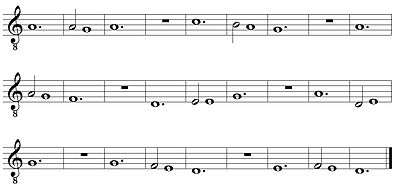Isorhythm

Isorhythm (from the Greek for "the same rhythm") is a musical technique that arranges a fixed pattern of pitches with a repeating rhythmic pattern.
Detail
Isorhythm consists of an order of durations or rhythms, called a talea ("cutting", plural taleae), which is repeated within a tenor melody whose pitch content or series, called the color (repetition), varied in the number of members from the talea. The term was coined in 1904 by Friedrich Ludwig (1903–04, 223) to describe this practice in 13th century polyphonic motets, but it later became more widely applied, especially to periodic repetition or rhythmic recurrence in tenors and other parts of 14th- and early 15th-century compositions, motets in particular (Bent 2001). The technique is also found in the music of India, and in works by modern composers such as Alban Berg, Olivier Messiaen, John Cage, and George Crumb. It may be used in all voices or only a few voices. In motets, it began in the tenor voice but was then extended to higher ones.
Ars nova composer Philippe de Vitry has been credited with the invention of the technique, but it "was neither an invention of Philippe de Vitry nor his exclusive property in the early fourteenth century" (Hoppin 1978, 363). Recent scholarship has argued that isorhythmic techniques in thirteenth-century motets should be reevaluated and that the "boundaries between the ars antiqua and ars nova potentially obfuscate our understanding of isorhythmic practice and its development" (Lanford 2011)).
The talea in early isorhythmic compositions was usually a short sequence of only a few notes, often corresponding to a rhythmic mode. In the course of the 14th century, taleae became much longer and more elaborate, and were used to structure much more large-scale works, where each color and talea constituted a substantial structural section of a composition measuring many bars. Around 1400, the technique of the diminution motet became common: a long tenor color was repeated several times according to different mensuration rules, making its performance faster by a fixed proportion each time. This technique was still used in the large-scale ceremonial motets by Guillaume Dufay in the mid-15th century, but his work also marks the extensive use of the more fluid polyphonic styles of the early renaissance.
The isorhythmic motet
These motets, written during the Ars Nova period of the 14th century, feature the isorhythmic principles of talea and color. Composers include Machaut and Philippe de Vitry. An example of an isorhythmic motet is Garrit Gallus/In nova fert/Neuma, attributed to Philippe de Vitry in the first half of the 14th century.
_isorhythmic_tenor.svg.png)
Sources
- Bent, Margaret (2001). "Isorhythm". The New Grove Dictionary of Music and Musicians, second edition, edited by Stanley Sadie and John Tyrrell. London: Macmillan Publishers.
- Hoppin, Richard H. (1978). Medieval Music. New York: W.W. Norton & Co. ISBN 0-393-09090-6.
- Lanford, Michael (2011). "A Reevaluation of Isorhythm in the "Old Corpus" of the Montpellier Codex." College Music Symposium 51: (retrieved on 4 September 2013).
- Ludwig, Friedrich (1903–04). "Die 50 Beispiele Coussemaker's aus der Handschrift von Montpellier". Sammelbände der Internationalen Musik-Gesellschaft 5:177–224.